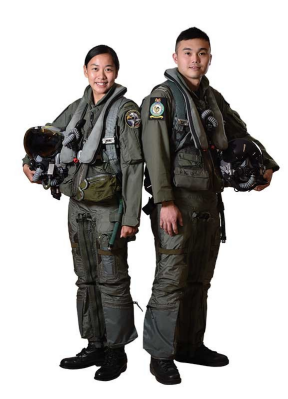SUIT UP
PHOTO // James Ng
Does the suit maketh the man? When it comes to the flight suit, it's a lot more than just a fashion statement.
For the highly trained aviators of the Republic of Singapore Air Force's (RSAF's) 149 Squadron (SQN), aerial combat manoeuvres can see them soaring at heights of up to 20,000m and at speeds of over Mach 2.5 in their F-15SGs.
With each of the F-15SG's two engines producing 29,000 pounds of thrust, the fighter jet is able to pull up to 9Gs (nine times the force of gravity).
In such conditions, the pilots and Weapon Systems Officers (Fighter) [WSO(FTR)s] need special equipment to help them endure the stresses of flight and effectively utilise the weapons at their disposal.
The first layer that they wear is their coveralls, a full body garment made of Nomex - a polymer similar to nylon but with added thermal, chemical and radiation resistance.
Over their coveralls, they don the Full Coverage Anti-G Trousers (FCAGT), which were introduced to all RSAF fighter squadrons this year.
Anti-G suits usually have five air bladders - one over the abdomen, one over each thigh, and one over each calf - which inflate to reduce the amount of blood that can pool in the lower limbs during high-G manoeuvres.
This allows more blood to be pumped to the brain so that aviators are less likely to experience G-induced Loss of Consciousness.
While such conventional anti-G suits provide 1 to 1.5Gs of protection, the FCAGT can provide 2 to 2.5Gs of protection.
This is because the FCAGT's air bladders fully cover the limbs, offering 95 percent lower body coverage compared to the five-bladder suit which only provides 40 percent lower body coverage. This means 50 percent less energy expenditure for the air crew when using the FCAGT.
Besides the anti-G suit, pilots and WSO(FTR)s have additional flight gear such as the Combat Edge Counter Pressure Vest, Survival Vest, Torso Harness, and Life Preserver Unit.
The final piece of equipment is the HGU 55/P helmet. Made by Gentex, the helmet is made of a combination of graphite and aramid to reduce head-borne weight while maintaining strength.
With the Joint Helmet Mounted Cueing System (JHMCS), information such as the aircraft s flight parameters and the position of other aircraft onto the helmet visor.
Captain Nah Jinping, an F-15SG pilot of 149 SQN, explained: "One of the difficulties of air combat is that of visually acquiring hostile aircraft. With the JHMCS, symbols are displayed to direct the pilot to the location of the hostile aircraft.
"Typically, the JHMCS helps pilots visually acquire hostile aircraft twice as fast and this translates into being able to employ weapons faster and shoot earlier."
- Coveralls - The coveralls that flight crew wear are made of Nomex, which provides added protection in the event of fire. It also allows for identification patches - such as the 149 SQN and F-15SG insignias - to be attached to the Velcro patches on the coveralls.
- Combat Edge Counter Pressure Vest - When flying at high altitudes, decreasing air pressure can make it difficult to inhale. The Counter Pressure Vest has air bladders located on the front and back of the chest which inflate and deflate accordingly as the air crew inhales and exhales, allowing them to breathe properly at high altitudes and low air pressure.
- Full Coverage Anti-G Trousers - The FCAGTS is connected to a G-sensitive valve in the F-15SG, and as gravitational forces increase, air within the aircraft is regulated and pumped into the anti-G suit to inflate it accordingly. The air bladders fully cover the lower limbs, reducing fatigue as the crew requires less effort to counteract the effects of G. This in turn allows them to focus on aerial combat.
- Life Preserver Unit - The unit contains a floatation assembly that will inflate upon contact with water.
- Torso harness - The harness is attached to the seat and functions like a seatbelt to secure aviators.
- HGU 55/P Helmet - The strong but lightweight helmet worn by pilots and WSO(FTR)s works with the JHMCS connected to the aircraft. Relevant information is displayed to the pilot s right eye through a projection system that displays the information on a specially coated visor. This information includes the aircraft s flight parameters and the position of other hostile or friendly aircraft.










